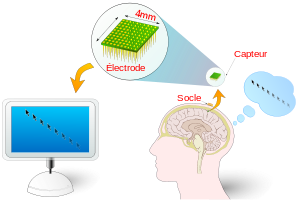
- Image via Wikipedia
The technological progress that revolutionized computing, electronics, and robotics in the 20th century will transform our bodies and enhance our brains in the 21st.
Scarcely a decade has passed since scientists painstakingly sequenced the first bacterial genome, yet today automated human genome sequencing is becoming routine, heralding a new era of medicine. Replacement tissues and even organs can now be grown from a patient’s own cells and used without risk of immune rejection. Genetic therapies for a plethora of debilitating conditions are on the horizon; brain and body imaging technologies allow early discovery of potentially harmful pathologies. But as these developments have unfolded, another area of research has simultaneously matured to rival them in its dramatic potential to help people. It’s called neuroengineering.
My colleagues and I have expected these events for years, but we are still awed by the results; some things are so powerful that, even if you know they are coming, they remain breathtaking when they actually arrive. Watching a person move a robotic limb or control the functions of a computer, through thought alone, we have little choice but to stare in amazement. These breakthroughs were made possible by prototype brain-computer interfaces (BCIs), which allow direct communication between the brain and external devices.
Prototype BCIs now facilitate basic motor control of prosthetic limbs and hands, computer keyboards and cursors, and even some features of computer games; new sensory BCI can restore damaged hearing to acceptable levels, and to a limited degree, speech and vision. Though much work remains to be done, many who have witnessed these recent successes are confident that similar but more sophisticated BCI technologies will eventually become routine and widespread.
As these neuroengineering capabilities have emerged, powerful computers, digital storage devices, software, and networking technologies have also relentlessly improved, and these dual progressions now offer a remarkable synergy. Although our minds are quite good at certain things, they absorb, process, store, recall, and share many types of information very slowly and inaccurately. In contrast, computers and digital storage devices excel at these tasks, but our eyes and fingers combined with current computer interfaces (touchscreens, keyboards, mice, and monitors) still provide extremely inefficient exchange of information. Consequently, vital questions lie before us: Should demonstrations of sensory and motor BCI technologies give us reason to expect we could use computers in an analogous manner, to extend cognitive functions, such as learning and memory, in a way that seems as natural as using our own minds? Can we move beyond sensorimotor BCI to create cognitive BCI?
Envision far more efficient learning, allowing the rapid accumulation of or access to knowledge it now takes years to learn. Picture a memory that behaves exactly as you’d like, even in middle age and beyond, where recollections normally begin to lose their edge. Imagine simply remembering all the important information you’d like to recall.
These speculative excursions where we are relieved from our modern state of information overload and forgetfulness allow us a glimpse, a taste of what sophisticated cognitive
BCI might enable. From our current vantage point, such spectacular developments are not on the immediate horizon. Indeed, some eminent neuroscientists have suggested we’ll need to understand far more about higher brain functions, and perhaps consciousness itself, to even consider tackling cognitive BCI. But there are sound, compelling reasons to believe the task may not be quite so daunting.









